Reading Comprehension Text and Exercises
A Guide to South American Cuisine
South America is a continent made out of 12 different countries, famous for football, carnivals, numerous tourist attractions and delicious food. With their rich history and diverse populations, South American countries offer delicious traditional dishes suited for everyone's taste and budget.
Click Here for Step-by-Step Rules, Stories and Exercises to Practice All English Tenses
A Brief History of South American Food
- Corn and potato are the staple of native South American food. Many South Americans make fresh cornbread and corn tortillas (thin flatbread) every day.
When it comes to potatoes, chuño is definitely worth mentioning. Chuño is a freeze-dried potato product which originates before the 13th century. Due to its nutritional value and portability, chuño was a favorite dish of South American soldiers. - When the first Europeans arrived to South America, they introduced new foods. In particular, they brought animals that were not native to South America, like pigs, chickens, cows and goats.
South Americans also adopted wheat and almonds from the Europeans, while the Europeans brought potato and corn back to Europe. - European occupying powers also shipped slaves from Africa. Over the years, African populations also made an impact on South American cuisine.
For example, Menudo, a traditional soup, derived the Spaniards' habit of giving cow's intestines (stomach) to their slaves, so the slaves learned how to season it well and make it tasty. - Today, foods such as quinoa or chia seeds, originating from South America, are universally accepted as super foods, popular for their great nutritional value.
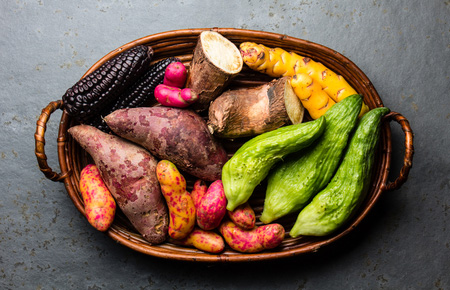
Soups and Stews
Sopa de mondongo is one of the soups that are eaten across the continent. They are many variations of this slow-cooked tripe (cow's or pig's stomach) and vegetables soup. While in Colombia this soup is considered to be an addition to a larger meal, the Venezuelans see this soup as being too heavy for the stomach, so they eat it as the main course.
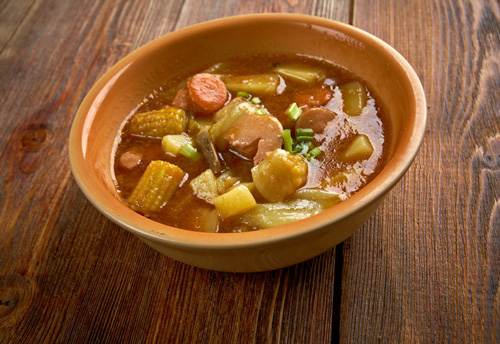
Sea food is eaten all over South America. In Brazil, fish stew called Moqueca is particularly popular. This dish is made with salt water fish, and optionally served with prawns. Records show that people in Brazil have been making this dish for at least 300 years.
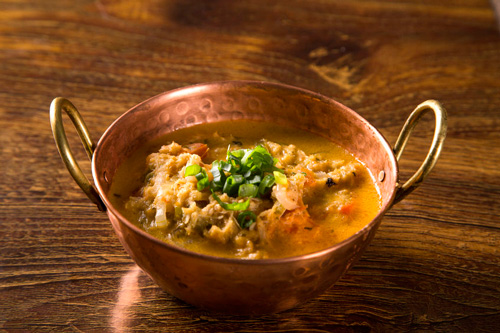
Fun fact: Paraguayan dish called sopa paraguaya (Paraguyan soup) is actually not a soup, but a spongy corn cake, made with cheese and milk.
Main Course Meat Dishes
Originating from Peru, ceviche is one of the dishes whose popularity has spread across the world. This very unique dish is typically made from fresh raw fish cured in lemon or lime juice. Although it is delicious, you must be very careful with this dish, because not preparing and consuming it fresh could lead to food poisoning.
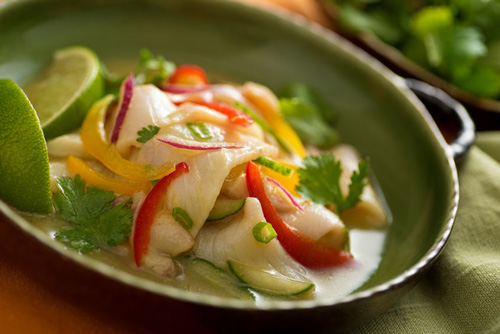
Churrasco refers to beef or, more generally, grilled meat, sometimes also called asado in countries such as Uruguay. In Chile, churrasco sandwich is accompanied with tomato, avocado and mayonnaise, while churrasco a lo pobre (poor man's churrasco) is eaten with French fries, fried egg and onions. Churrascarias are popular fast food restaurants which serve all-you-can-eat grilled meat for a fixed price.
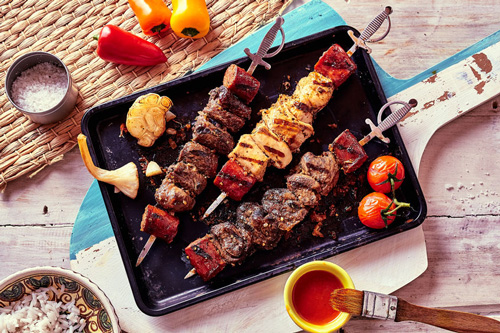
Desserts
South Americans love desserts. In Brazil, the most popular ones are brigadeiros. This dessert can come in different colors and flavors, but the base is always the same: sweetened condensed milk is heated with cocoa power until they form a paste, which is then rolled into small balls, and covered with toppings such as sprinkles or coconut shavings. Brigadeiros are often served at birthday parties.
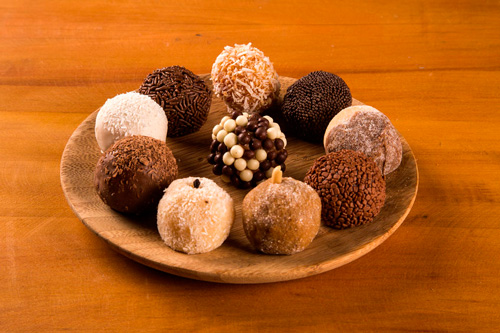
Picarones, originating from Peru, are one of the oldest desserts, dating back to Peru's colonial days. Since there are more than 3,800 types of potatoes growing in Peru, desserts are often made with potatoes. Sweet potato, mixed with squash, is used for picarones. In combination with flour, sweet potatoes are turned into light and airy deep-fried doughnuts and served with syrup.
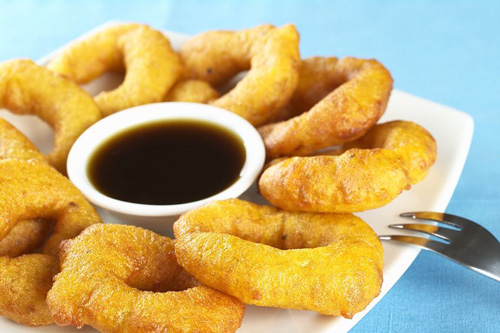
Fun fact: Wheat did not grow in South America, so white flour was very expensive. Two Venezuelan sisters invented a cake that did not need flour, but was based on mashed plantains (bananas) and corn instead. The cake, called Torta Bejarana, is still very popular, normally showered with sesame seeds.
Comprehension Exercises
Vocabulary Questions
- What does "cured" mean?
- eaten with rice or corn
- cooked for a really long time
- preserved by salting, drying or smoking
- What does "topping" mean?
- a cake which has whipped cream
- a layer of food added to the base
- a drink that accompanies the main dish
- What does "native" mean?
- a person who fought in a battle
- the oldest person in the family
- a person born in a specific place
- What does "colonial" mean?
- relating to an occupying power's colony
- living in traditional villages
- existing in parts, not as a whole
- What does "staple" mean?
- a product that is basic and important in people's everyday lives
- the most exported product of a country
- the cheapest product in supermarkets
Collocation Questions
- Menudo derives ___________ a Spanish habit.
- of
- by
- from
- Brigadeiros are often covered with coconut ___________.
- seeds
- shavings
- sprinkles
- Grilled meat is a common ___________ course for many South Americans.
- leading
- main
- central
- Due to its ___________, chuño was a favorite dish of South American soldiers.
- portability
- flexibility
- movability
- In combination ___________ flour, sweet potatoes are turned into doughnuts.
- of
- with
- to
- Condensed milk and cocoa powder are cooked until they ___________ a paste.
- form
- structure
- model
- People think sopa de mondongo is too ___________ for the stomach.
- hard
- difficult
- heavy
- The key to a tasty menudo is to ___________ it well.
- flavor
- season
- taste
- Nowadays, Torta Bejarana is ___________ with sesame seeds.
- showered
- bathed
- bombarded
- Some cakes are made with ___________ plantains..
- slushed
- smashed
- mashed
Wh Questions
- What did the first Europeans bring back to Europe from South America?
- chickens and goats
- potato and corn
- condensed milk
- How is churrasco a lo pobre different from a typical churrasco sandwich?
- It is served with a fried egg.
- It is much cheaper.
- It is not made with grilled meat.
- Where can you expect to eat sopa de mondongo as the main course?
- in Bolivia
- in Spain
- in Venezuela
- When did Brazilians start making monqueca?
- in the 6th century
- in the past ten years
- at least 300 years ago
- Why should you be careful when you eat ceviche?
- because you can get food poisoning
- because the fish is still alive
- because it can be really expensive
Evaluating Statements
- Based on the information in this lesson, which statement is true?
- It is forbidden to eat lama meat in South America.
- Lama meat is commonly eaten in some parts of South America, mainly Bolivia.
- Based on the information in this lesson, which statement is false?
- In churrascarias, you can eat up to 2 pounds of grilled meat.
- In churrascarias, you can eat as much grilled meat as you want.
True or False?
- Based on the information in this lesson, is the following statement true or false?
"People from all over the world agree that quinoa and chia seeds are really healthy foods." - True
- False
- Based on the information in this lesson, is the following statement true or false?
"Sopa paraguya is traditional Peruvian fish soup." - True
- False
Answer Key
1. C | 2. B | 3. C | 4. A | 5. A | 6. C | 7. B | 8. B | 9. A | 10. B | 11. A | 12. C | 13. B | 14. A | 15. C | 16. B | 17. A | 18. C | 19. C | 20. A |21. B | 22. A | 23. A | 24. B
Get Updates, Special Offers, and English Resources
Download your FREE GIFT (the first two chapters of
English Short Stories Book and Workbook)
as soon as you join!

By submitting your email, you consent to receiving updates and newsletters from us and to the sharing of your personal data with third parties for the purposes of sending you communications. We will not spam you. You can unsubscribe at any time. For more information, please see our privacy policy.





